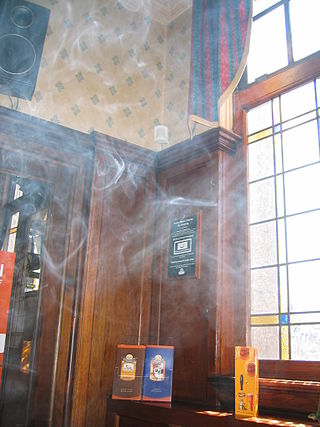
Tobacco smoke is a sooty aerosol produced by the incomplete combustion of tobacco during the smoking of cigarettes and other tobacco products. Temperatures in burning cigarettes range from about 400 °C between puffs to about 900 °C during a puff. During the burning of the cigarette tobacco, thousands of chemical substances are generated by combustion, distillation, pyrolysis and pyrosynthesis. Tobacco smoke is used as a fumigant and inhalant.

Smoking cessation, usually called quitting smoking or stopping smoking, is the process of discontinuing tobacco smoking. Tobacco smoke contains nicotine, which is addictive and can cause dependence. As a result, nicotine withdrawal often makes the process of quitting difficult.

Luther Leonidas Terry was an American physician and public health official. He was appointed the ninth Surgeon General of the United States from 1961 to 1965, and is best known for his warnings against the dangers and the impact of tobacco use on health.

Passive smoking is the inhalation of tobacco smoke, called passive smoke, secondhand smoke (SHS) or environmental tobacco smoke (ETS), by individuals other than the active smoker. It occurs when tobacco smoke diffuses into the surrounding atmosphere as an aerosol pollutant, which leads to its inhalation by nearby bystanders within the same environment. Exposure to secondhand tobacco smoke causes many of the same diseases caused by active smoking, although to a lower prevalence due to the reduced concentration of smoke that enters the airway.

The Public Health Cigarette Smoking Act is a 1970 federal law in the United States designed to limit the practice of tobacco smoking. As approved by the United States Congress and signed into law by President Richard Nixon, the act required a stronger health warning on packages, saying "Warning: The Surgeon General Has Determined that Cigarette Smoking Is Dangerous to Your Health". It also banned cigarette advertisements on American radio and television.

The Comprehensive Smoking Education Act of 1984 is an act of the Congress of the United States. A national program established in order to improve the availability of information on health risks related to tobacco smoking, to amend the Federal Cigarette Labeling and Advertising Act so that cigarette warning labels would be different, and for other reasons, the Comprehensive Smoking Education Act was enacted with a purpose to, as stated in Section 1 of the Act, "provide a new strategy for making Americans more aware of any adverse health effects of smoking, to assure the timely and widespread dissemination of research findings and to enable individuals to make informed decisions about smoking". Adopted by Congress in 1984 and effective October 12, 1984, the Comprehensive Smoking Education Act created a rotational warning system that required all cigarette packages and advertisements to rotate the following four warnings every three months:

Tobacco products, especially when smoked or used orally, have negative effects on human health. Researchers have addressed concerns about these effects for a long time. They have focused primarily on cigarette smoking.
A pack-year is a clinical quantification of cigarette smoking used to measure a person's exposure to tobacco. This is used to assess their risk of developing lung cancer or other pathologies related to tobacco use. However, it is difficult to rely on the assessment based on the pack-year due to the different nature of the packaging by different companies.

A menthol cigarette is a cigarette infused with the compound menthol which imparts a “minty” flavor to the smoke. Menthol also decreases irritant sensations from nicotine by desensitizing receptors, making smoking feel less harsh compared to regular cigarettes. Some studies have suggested that they are more addictive. Menthol cigarettes are just as hard to quit and are just as harmful as regular cigarettes.

Nicotine dependence is a state of dependence upon nicotine. Nicotine dependence is a chronic, relapsing disease defined as a compulsive craving to use the drug, despite social consequences, loss of control over drug intake, and emergence of withdrawal symptoms. Tolerance is another component of drug dependence. Nicotine dependence develops over time as a person continues to use nicotine. The most commonly used tobacco product is cigarettes, but all forms of tobacco use and e-cigarette use can cause dependence. Nicotine dependence is a serious public health problem because it leads to continued tobacco use, which is one of the leading preventable causes of death worldwide, causing more than 8 million deaths per year.

A Frank Statement to Cigarette Smokers was a historic first advertisement in a campaign run by major American tobacco companies on January 4, 1954, to create doubt by disputing recent scientific studies linking smoking cigarettes to lung cancer and other dangerous health effects.

Tobacco control is a field of international public health science, policy and practice dedicated to addressing tobacco use and thereby reducing the morbidity and mortality it causes. Since most cigarettes and cigars and hookahs contain/use tobacco, tobacco control also concerns these. E-cigarettes do not contain tobacco itself, but (often) do contain nicotine. Tobacco control is a priority area for the World Health Organization (WHO), through the Framework Convention on Tobacco Control. References to a tobacco control movement may have either positive or negative connotations, depending upon the commentator.

Tobacco smoking has serious negative effects on the body. A wide variety of diseases and medical phenomena affect the sexes differently, and the same holds true for the effects of tobacco. Since the proliferation of tobacco, many cultures have viewed smoking as a masculine vice, and as such the majority of research into the specific differences between men and women with regards to the effects of tobacco have only been studied in-depth in recent years.

Regulation of tobacco by the U.S. Food and Drug Administration began in 2009 with the passage of the Family Smoking Prevention and Tobacco Control Act by the United States Congress. With this statute, the Food and Drug Administration (FDA) was given the ability to regulate tobacco products.
Jeffrey E. Harris, is an economist and physician who has been on the faculty of the Economics Department of the Massachusetts Institute of Technology since 1977. He received an AB from Harvard University, as well as an MD (1974) and a PhD in Economics (1975) from the University of Pennsylvania. Having trained in internal medicine at the Massachusetts General Hospital (1974-1977), he maintained a medical practice at that institution until 2006. Since then, he has continued to practice as an internist at federally sponsored community health centers in Rhode Island, where the majority of his patients have poverty-level incomes and are not fluent in English.
The use of electronic cigarettes (vaping) carries health risks. The risk depends on the fluid and varies according to design and user behavior. In the United Kingdom, vaping is considered by some to be around 95% less harmful than tobacco after a controversial landmark review by Public Health England.
The scientific community in the United States and Europe are primarily concerned with the possible effect of electronic cigarette use on public health. There is concern among public health experts that e-cigarettes could renormalize smoking, weaken measures to control tobacco, and serve as a gateway for smoking among youth. The public health community is divided over whether to support e-cigarettes, because their safety and efficacy for quitting smoking is unclear. Many in the public health community acknowledge the potential for their quitting smoking and decreasing harm benefits, but there remains a concern over their long-term safety and potential for a new era of users to get addicted to nicotine and then tobacco. There is concern among tobacco control academics and advocates that prevalent universal vaping "will bring its own distinct but as yet unknown health risks in the same way tobacco smoking did, as a result of chronic exposure", among other things.
The 1950 Wynder and Graham Study was conducted by Ernest Wynder and Evarts Graham and was entitled "Tobacco Smoking as a Possible Etiologic Factor in Bronchiogenic Carcinoma: A Study of Six Hundred and Eighty-Four [684] Proved Cases". It was published on May 27, 1950. It was a case-control study to determine the relationship between various external factors and the development of bronchogenic carcinoma. The study concluded that long-term tobacco usage contributes to the onset of lung cancer, as an overwhelming majority (96.5%) of the men with the disease were classified as moderate to heavy smokers for an extended period of time, compared to a lower percentage of the general hospital population control group.
Horace Joules LRCP, MRCP, MRCS, FRCP was a British physician, health administrator and health campaigner, who played an important role in promoting public health and preventative medicine; particularly the link between cigarette smoking and lung cancer following the work of Richard Doll, Austin Bradford Hill, Ernst Wynder and Evarts Graham, and the adverse effects of air pollution.

Smoker's macrophages are alveolar macrophages whose characteristics, including appearance, cellularity, phenotypes, immune response, and other functions, have been affected upon the exposure to cigarettes. These altered immune cells are derived from several signaling pathways and are able to induce numerous respiratory diseases. They are involved in asthma, chronic obstructive pulmonary diseases (COPD), pulmonary fibrosis, and lung cancer. Smoker’s macrophages are observed in both firsthand and secondhand smokers, so anyone exposed to cigarette contents, or cigarette smoke extract (CSE), would be susceptible to these macrophages, thus in turns leading to future complications.












